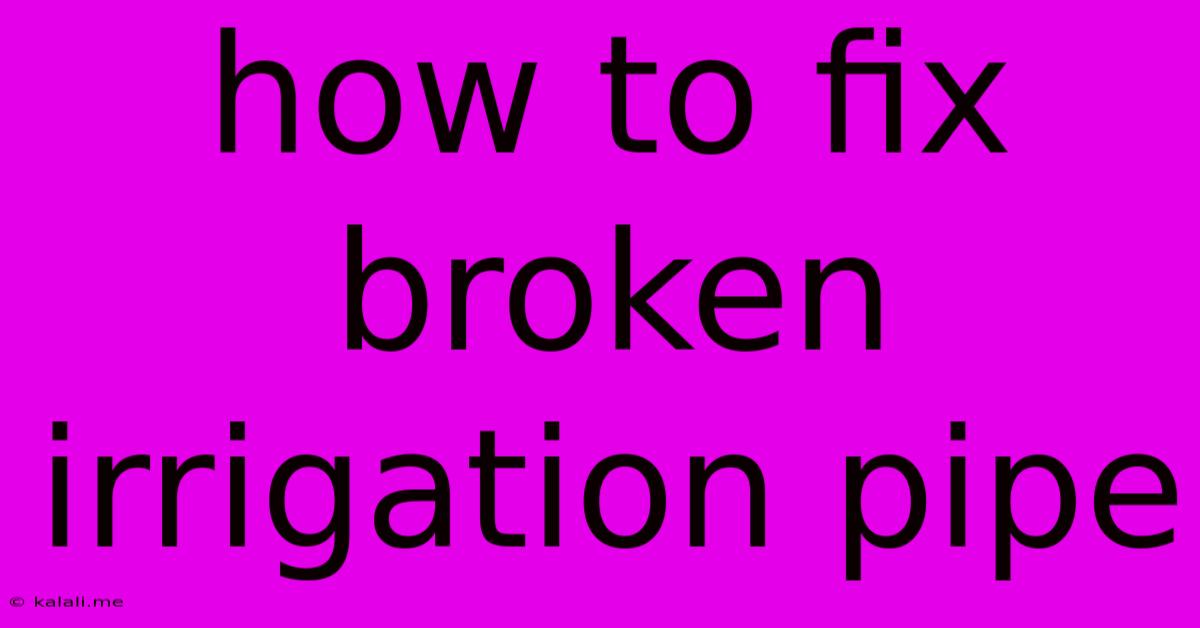How To Fix Broken Irrigation Pipe
Kalali
Jun 09, 2025 · 4 min read

Table of Contents
How to Fix a Broken Irrigation Pipe: A Comprehensive Guide
Finding a broken irrigation pipe can be a frustrating experience, leading to wasted water and potentially damaged landscaping. This comprehensive guide will walk you through identifying the problem, selecting the right repair method, and completing the fix efficiently and effectively. Whether you're dealing with a small crack or a significant break, we've got you covered.
Identifying the Problem: Locating the Leak and Assessing the Damage
Before you reach for your tools, take the time to accurately pinpoint the location and severity of the damage. A thorough inspection will determine the best repair strategy. Here's what to look for:
- Visible Cracks or Holes: These are the easiest to identify. Look closely along the pipe's length for any visible fractures or punctures.
- Soggy Patches of Ground: Water leaks often manifest as unusually damp or muddy areas in your lawn. This can help you narrow down the search area if you can't see the damage itself.
- Low Water Pressure: A significant leak can drastically reduce the water pressure in your irrigation system. This is a clear sign of a problem somewhere in the line.
- Water Meter Check: Compare your water meter reading before and after running your irrigation system. A significant increase may indicate a leak.
Once you've located the leak, assess its size and the type of pipe involved. This will influence your choice of repair method.
Choosing the Right Repair Method: From Simple Fixes to Major Repairs
The best approach depends on the extent of the damage and your DIY skills. Here are some common methods:
- Small Cracks (Less than 1/4 inch): For minor cracks, a repair clamp is often sufficient. These clamps fit around the pipe and secure a rubber gasket over the crack, creating a watertight seal. This is a quick and easy solution for superficial damage.
- Larger Cracks or Holes (More than 1/4 inch): Larger breaks usually require more substantial repairs. Consider using a PVC pipe repair coupling. This involves cutting out the damaged section of the pipe and replacing it with a new section using a coupling to join the ends. You'll need PVC cement and appropriate pipe cutters for this method.
- Severe Damage or Multiple Leaks: If the pipe is severely damaged or you have multiple leaks along a single pipe, it's best to replace the entire section of pipe. This guarantees a long-term solution and avoids recurring problems.
- Using specialized Pipe Repair Compounds: For smaller holes and cracks, certain epoxy-based compounds can provide a durable seal. Carefully follow the manufacturer's instructions.
Tools and Materials You'll Need
The specific tools and materials will depend on your chosen repair method. However, here's a general list that covers most scenarios:
- Shovel: To expose the damaged pipe.
- Pipe Cutter or Hacksaw: To cut through the pipe (if necessary).
- Measuring Tape: To measure the damaged section.
- Repair Clamps or Couplings: Based on the severity of the damage.
- PVC Cement: (If using couplings or other PVC fittings).
- Sandpaper or File: For smoothing pipe ends before joining.
- Gloves and Safety Glasses: Essential for protection.
- Bucket and towels: To clean up any spills and prevent further water loss.
Step-by-Step Repair Process (using a PVC coupling as an example):
- Turn off the water supply: Locate your main irrigation valve and turn it off completely.
- Expose the damaged pipe: Carefully dig around the broken pipe section to expose it adequately for repair.
- Cut out the damaged section: Use a pipe cutter or hacksaw to cleanly cut out the damaged portion of the pipe, leaving straight, even ends.
- Clean the pipe ends: Sand or file the ends of the pipe to remove any burrs or rough edges.
- Apply PVC cement: Apply a thin layer of PVC cement to the inside of the coupling and the ends of the pipe sections.
- Join the pipe sections: Carefully push the pipe ends into the coupling and hold them firmly for a few minutes until the cement bonds.
- Backfill the trench: Carefully refill the trench, ensuring the pipe is properly supported and covered.
- Turn the water back on: Turn your main irrigation valve back on and check for any leaks.
Preventing Future Pipe Breaks
Regular maintenance can significantly reduce the likelihood of future pipe breaks. This includes:
- Annual System Inspections: Check your irrigation system for leaks and damage at least once a year, preferably before the start of the irrigation season.
- Proper Winterization: In colder climates, ensure your system is properly winterized to prevent pipes from freezing and bursting.
- Avoid Over-Watering: Excessive water pressure can stress the pipes, increasing the risk of breaks.
- Proper Installation: Ensure the pipes are correctly installed and buried deep enough to prevent damage from freezing temperatures or physical impact.
By following these steps, you can effectively repair a broken irrigation pipe and avoid costly repairs or water waste. Remember safety first, and if you're unsure about any part of the process, don't hesitate to contact a professional plumber or irrigation specialist.
Latest Posts
Latest Posts
-
What Didnt Get Caught In The Rain
Jun 09, 2025
-
Peel And Stick Vinyl Plank Flooring
Jun 09, 2025
-
What Is The Opposite Of Gray
Jun 09, 2025
-
How To Set Query Timeouts To Prevent Stuck Queries Rds
Jun 09, 2025
-
Why Is My Palm Plant Turning Yellow
Jun 09, 2025
Related Post
Thank you for visiting our website which covers about How To Fix Broken Irrigation Pipe . We hope the information provided has been useful to you. Feel free to contact us if you have any questions or need further assistance. See you next time and don't miss to bookmark.